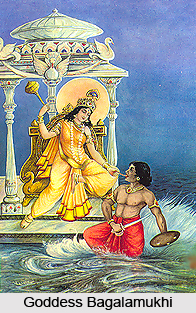 Shri Pitambara Peeth is one of the most famous Shakti Peetha of Baglamukhi, which was established by Bramhaleen Pujyapaad Rashtraguru Anant Shree Swamiji Maharaj in the 1920s. He also established the temple of goddess Dhumavati within the ashram. Dhumavati and Baglamukhi are the two of the ten Mahavidyas.
Shri Pitambara Peeth is one of the most famous Shakti Peetha of Baglamukhi, which was established by Bramhaleen Pujyapaad Rashtraguru Anant Shree Swamiji Maharaj in the 1920s. He also established the temple of goddess Dhumavati within the ashram. Dhumavati and Baglamukhi are the two of the ten Mahavidyas.
In addition to those, there are temples of Parshuram, Hanuman, Kal Bhairav and other gods and goddesses spread across the large area of the Ashram. Currently the Peeth is maintained by a trust. There is a Sanskrit library that was established by the Pujyapaad, and is maintained by the Ashram. On of the inimitable feature of the Ashram is its endeavor to spread aura of Sanskrit language to young children, free of cost. The devotees called Pujyapaad `Swamiji` or `Maharaj`.
No one knows exactly from whence he came, or his original name, nor did he disclose it to anyone. Pujyapaada was a strong devotee of Goddess Pitambara. He had an in-born liking for the Sanskrit language. He had sound knowledge of Urdu, Persian, Arabic, English, Pali and Prakrit languages. He adored classical music, and several great classical musicians of that period, visited his Ashram. The Shakti Peeth has a Vankhandeshwar Shiva Temple, dating back to the times of the Mahabharata. The ashram is around 3 km from Datia Railway station.
In Hinduism, Bagalamukhi is one of the ten mahavidyas(great wisdom). Bagalamukhi Devi bangs the devotee`s misconceptions and delusions with a bludgeon. The name literally means `crane-faced `. The name `Bagla` is a distortion of the original Sanskrit root `ValgA`. She is golden complexioned and her cloth is yellow. She sits in a golden throne in the midst of an ocean of nectar full of yellow lotuses. A crescent moon adorns her head. The goddess is described in two different ways in various texts- the `Dwi-BhujA` (two handed), and the `ChaturbhujA` (four handed). The Dwi-BhujA depiction is the more familiar and is described as the `soumya` pr milder form. She is shown holding a club in her right hand and with which she beats the demon, while pulling his tongue out with her left hand. This image is sometimes represented as an exposition of `sthambhana`, the power to stun or paralyze one`s enemy to silence. This is precisely one of the boons for which Bagalamukhi`s devotees worship her.
The legendary story that looms around the origin of Bagalamukhi that, once upon a time, a huge storm lashed onto earth, and threatened to destroy all of god`s creation. As a result all the gods assembled in the Saurashtra region. Goddess Bagalamukhi emerged from the `Haridra Sarovar`, pacified by the prayers of the gods, calmed down the destructive storm. Yet another story goes on to explain that a demon named Madan underwent penance and won the boon of vak siddhi, according to which whatever he said, happened the exact way. Starting to take his boon as a point to harass innocent people, the heavenly livings were severely enraged, thereby worshipping Bagalamukhi. She stopped the demon`s rampage by gripping his tongue and silencing his speech forever.
However, before she could kill him, he requested her that he is worshipped alongside the goddess, and she yielded. That is why Madan (the demon) is shown with her together. A skilled pandit performs the Bagalamukhi Puja, as a slightest mistake in the ritual can bring about worse effects. The puja is organized according to the Vedic ritual, to overwhelm enemies. It not only diminishes the power of the enemy, but also creates an atmosphere where he/she becomes hopelessly unaided. The Abhimantrit Bagalamukhi Yantra is also used for the same purpose. It shields the person from enemies and evils.





















